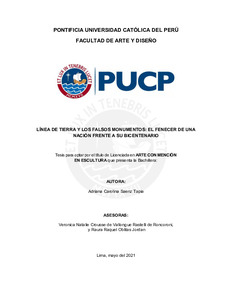| dc.contributor.advisor | Crousse de Vallongue Rastelli de Roncoroni, Veronica Natalie | |
| dc.contributor.author | Saenz Tapia, Adriana Carolina | |
| dc.date.accessioned | 2021-08-03T17:15:41Z | |
| dc.date.available | 2021-08-03T17:15:41Z | |
| dc.date.created | 2021 | |
| dc.date.issued | 2021-08-03 | |
| dc.identifier.uri | http://hdl.handle.net/20.500.12404/19811 | |
| dc.description.abstract | Esta tesis presenta el proyecto artístico Un Reflejo Del Cuerpo Peruano
Agonizante que conforma los proyectos de video instalación: Ars Corona Moriendi
y En Silencio Gimió El Grito Sagrado: Libertad Nunca, En Mis Tierras Nunca.
A partir de ello, planteamos la hipótesis de que existe un problema desde los
representantes máximos del Estado para poder proteger y preservar la vida humana
de manera digna, equitativa y justa a nivel nacional, situación que desemboca en
una muerte indigna e innecesaria. Adicionalmente, nos centramos, también, en la
dificultad de una posible construcción identitaria como una sociedad peruana
unificada. Esta situación, de falta de representatividad, se ve reflejada en uno los
símbolos más importantes de la celebración del centenario de independencia del
Perú, el monumento conmemorativo republicano al libertador Don José de San
Martín. Esto último nos permitió profundizar y conectar con aspectos indispensables
que conforma la historia de la escultura, los monumentos. Abordamos la
problemática bajo un breve recuento histórico sobre el desarrollo social del Perú
desde el periodo de su independencia, pasando por el centenario para llegar al
bicentenario, recuento histórico a razón de la crisis sanitaria por SARS-CoV-2. Esta
investigación presenta los objetivos a modo de preguntas, ya que no solo buscarán
ser abordadas teóricamente sino, también, por medio de la praxis artística:
¿Quiénes son las verdaderas víctimas del proceso de consolidación de la República
del Perú? ¿De qué manera la realidad social peruana es definida por la muerte?
¿Cómo ello puede ser traducido al campo del arte? Por ende, buscamos la
revaloración de la historia que nos constituye como república y la historia del declive
de los monumentos que constituye al desarrollo del ámbito escultórico del arte. | es_ES |
| dc.description.abstract | This thesis presents the artistic project A Reflection Of The Agonizing Peruvian
Body that conforms the video installation projects: Ars Corona Moriendi and En
Silencio Gimió El Grito Sagrado: Libertad Nunca, En Mis Tierras Nunca (In
Silence Moaned The Sacred Cry: Freedom Never, In My Lands Never).
Therefore, the hypothesis is that exists a problem from the highest representatives
of the State to be able to protect and preserve human life in a dignified, equitable
and fair way at a national level, a situation which leads to an undignified and
unnecessary death. Additionally, we also focus on the difficulty of a possible
construction of identity as a unified Peruvian society. This situation of lack of
representativeness is reflected in one of the most important symbols of the
celebration of the centenary of Peru's independence, the Republican
commemorative monument to the liberator Don José de San Martín. The latter
allowed us to deepen and connect with indispensable aspects that make up the
history of sculpture, the monuments. We approached the problem under a brief
historical account of the social development of Peru from the period of its
independence, passing through the centenary to reach the bicentenary, historical
account due to the health crisis caused by SARS-CoV-2. This research presents the
objectives as questions, since they will not only seek to be addressed theoretically
but also through artistic praxis: Who are the real victims of the process of
consolidation of the Republic of Peru? How is the Peruvian social reality defined by
death? How can this be translated into the field of art? Therefore, we seek the
revaluation of the history that constitutes us as a republic and the history of the
decline of the monuments that constitutes the development of the sculptural field of
art. | es_ES |
| dc.language.iso | spa | es_ES |
| dc.publisher | Pontificia Universidad Católica del Perú | es_ES |
| dc.rights | info:eu-repo/semantics/openAccess | es_ES |
| dc.rights.uri | http://creativecommons.org/licenses/by/2.5/pe/ | * |
| dc.subject | Simbolismo en el arte--Perú | es_ES |
| dc.subject | Identidad colectiva--Perú | es_ES |
| dc.subject | Monumentos históricos--Perú--Independencia | es_ES |
| dc.title | Línea de tierra y los falsos monumentos : el fenecer de una nación frente a su bicentenario | es_ES |
| dc.type | info:eu-repo/semantics/bachelorThesis | es_ES |
| thesis.degree.name | Licenciado en Arte con mención en Escultura | es_ES |
| thesis.degree.level | Título Profesional | es_ES |
| thesis.degree.grantor | Pontificia Universidad Católica del Perú. Facultad de Arte y Diseño | es_ES |
| thesis.degree.discipline | Arte con mención en Escultura | es_ES |
| renati.advisor.dni | 07255232 | |
| renati.advisor.orcid | https://orcid.org/0000-0002-8519-7927 | es_ES |
| renati.author.dni | 73027306 | |
| renati.discipline | 213256 | es_ES |
| renati.juror | Cisneros Velarde, Marta Susana | es_ES |
| renati.juror | Crousse de Vallongue Rastelli de Roncoroni, Veronica Natalie | es_ES |
| renati.juror | Oblitas Jordan, Raura Raquel | es_ES |
| renati.juror | Jaime Carbonel, Alejandro | es_ES |
| renati.juror | Huerta Mercado Tenorio, Víctor Alexander | es_ES |
| renati.level | https://purl.org/pe-repo/renati/level#tituloProfesional | es_ES |
| renati.type | http://purl.org/pe-repo/renati/type#tesis | es_ES |
| dc.publisher.country | PE | es_ES |
| dc.subject.ocde | http://purl.org/pe-repo/ocde/ford#6.04.09 | es_ES |






